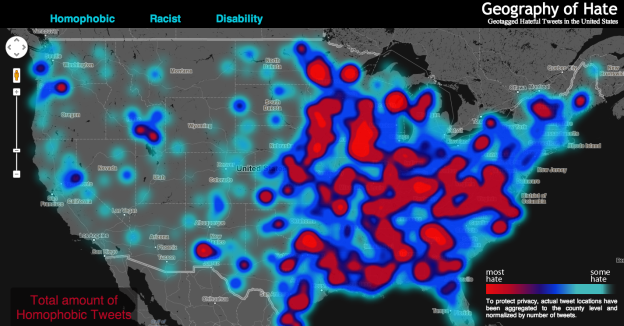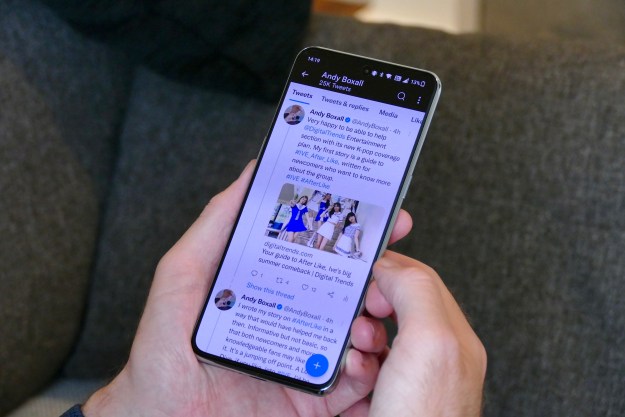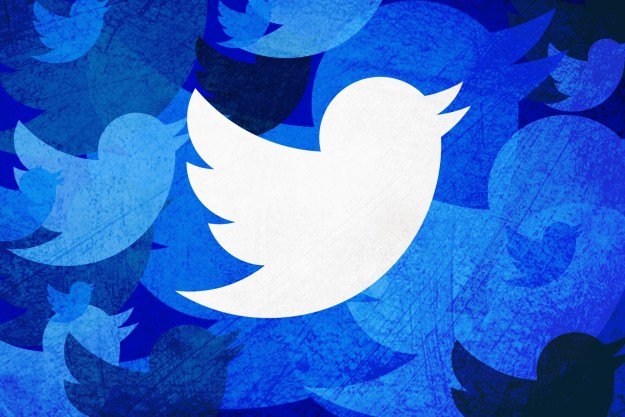
The Internet does many great things, but it also gives hate-mongerers a mask to hide behind. That’s been pretty well-established; there are a horrifying wealth of examples to fortify supporting the idea. And if that weren’t enough, there’s also an interactive map displaying exactly where the most odious comments on Twitter originate, and it suggests that there are many pockets of the U.S. blighted by homophobic, racist, and discriminatory vocabulary.
The map (which you can check out here) was created by Dr. Monica Stephens and her research team at Humboldt State University, and plots out 150,000 geo-tagged hateful tweets. The same team created a map that showed where the most virulent anti-Obama tweets came from during the 2008 campaign, and they were inspired to create this more general visual assessment after completing that project. Does this mean you can plan your next road trip to avoid pockets of especially rampant douchebaggery?
Not really. The map is a disturbing reminder that some people still regularly, casually, and malevolently use hateful words, although if you look at it you may make some incorrect assumptions about the most problematic areas. And the areas that appear largely Twitter-jerk free are, unfortunately, not so devoid of miscreants as an initial glance at the map suggests.
Clicking through the different slurs, you may notice that California appears largely slur-free. However, that’s not actually the case. As Stephens explains on the blog Floating Sheep, “For example, Orange County, California has the highest absolute number of tweets mentioning many of the slurs, but because of its significant overall Twitter activity, such hateful tweets are less prominent and therefore do not appear as prominently on our map. So when viewing the map at a broad scale, it’s best not to be covered with the blue smog of hate, as even the lower end of the scale includes the presence of hateful tweeting activity.”
So the areas that show up as especially hateful may actually have lower instances of overall negative tweets as other areas – but they’re getting called out on the map for being the areas where hate speech is a higher percentage of overall Twitter activity.
Since the map just highlights areas where hate speech is a bigger chunk of the conversation on Twitter, you can’t use it to zigzag your way through tolerant pockets of the country and avoid the more horrible ones. But it does serve as a sobering reminder that ignorance is still a huge social problem. Now, if you want to see where the most messed up Facebook or Instagram updates come from, there’s no map for that yet. But since a recent study indicated that some avid Facebook users may propagate racism, it’s reasonable to assume a map showing where Facebook’s hate speech comes from would be just as bountiful as the Twitter Hate Map.
There are people that make blogs devoted to shaming Twitter and Facebook users with ignorant content, in an attempt to scold people for their bad behavior. While these posts are good at exposing some truly reprehensible writing, they serve more to reinforce the readers’ sense of outrage than to actually inspire changed behavior from the people who write horrible stuff online.
What will make people stop using this type of language on social media? Twitter is facing a $50 million lawsuit in France because it didn’t initially comply with a request to give up user info for people who made anti-Semitic slurs on the site. While Twitter says it’s protecting privacy, not defending bigots, this incident shows that the commitment to free speech may face push back when it comes to quelling hate speech. And as the Hate Map shows, it’s not likely all the hateful speech will dry up without some sort of prodding – it’ s just too commonplace.
Editors' Recommendations
- Why is Twitter called X now? Here’s everything you need to know
- Australia threatens Twitter with huge fines over hate speech
- It’s not just you – Twitter is down for users around the world
- How to use Twitter Advanced Search
- Can’t stand using Instagram in 2022? This app fixes everything you hate about it


